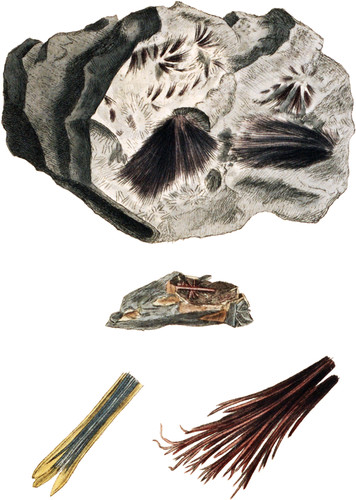 Enlarge
Enlarge
Exotic Mineralogy
Oxysulphuret of Antimony. Red Antimony
- Syn.
- Antimoine oxidé sulphuré. Antimonoine Rouge, Bourn. Cat. 404. Haüy, Tabl. 113.
- Antimoine hydrosulfuré. Haüy, Traité, 4. 276.
- Roth-spiessglaserz. Werner.
- Red Antimonial ore. Kirw. 2. 250.
- Roth-spiessglanzerz. Emmerl. 2. 477.
Red Antimony has long been esteemed as one of the most elegant ores of that metal; it is found in Saxony, Hungary, &c. , but is by no means a common Mineral; its matrix is generally Sulphuret of Antimony, or Quartz. In its most perfect form it occurs in scopiform bundles of acicular crystals of a rich deep red colour, with much lustre; these crystals are transparent and pliable, two characters which have been overlooked by every author except the Count de Bournon. Red Antimony also occurs in dull red films, or even pulverulent, coating decomposing crystals of the grey Sulphuret, in which case it is often accompanied by small crystals of Sulphur, and pulverulent Oxide of Antimony.
It is the opinion of Haüy that it is produced in general by the decomposition of the grey Sulphuret, and Bournon even supposes that it is always so, and that its acicular form arises from the splitting of the crystals of the grey Sulphuret during the progress of decomposition, for he has observed that the fibres of each Lave the same form, and that the grey may frequently be divided into spiculæ, approaching in fineness those of the red. The Count has specimens of the grey which have lost all the Sulphur from the surfaces of the crystals, and are covered in part with Oxide, which seems ready to peel off, and within which the Sulphuret appears to be dividing into spiculæ; of one of these crystals I have given a magnified figure, to illustrate the formation of the red. It appears to me tolerably certain that the filmy or pulverulent forms are produced simply by the decomposition of the grey, but I feel some hesitation in pronouncing that the constituent parts of a substance can he changed without destroying its texture completely, and I am the more inclined to think that the transparent spicuæ which occur in diverging groups, are formed, independently of the grey Sulphuret, by the direct aggregation of their constituent parts according to the regular laws of crystallization.
Chemists formerly considered the red Sulphuret of Antimony, whether native or artificial, (when it was called Kermes Mineral) as a combination of Antimony, Sulphur, and Hydrogen; but lately, upon the authority of Klaproth, and considering the process by which the glass of Antimony is formed, it is supposed to be a compound of the protoxide of Antimony with Sulphur.
| Antimony | 67.5 |
| Oxygen | 10.8 |
| Sulphur | 19.7 |
| Loss | 2.0 |
| 100.0 |
Is it not probable that, instead of its being an oxygenized Sulphuret, it is a simple Sulphuret containing a greater portion of Sulphur than the grey?
The larger specimen is in the cabinet of the British Museum; the others in that of the Count.

